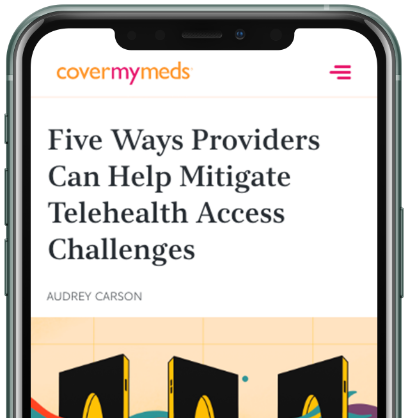Why Your Patients Might Want to Pay Cash For Their Prescriptions
When picking up a medication from the pharmacy, some patients may fare better reaching straight for their wallet rather than their insurance card.

In 2019, 40 percent of people with private insurance were on high deductible health plans, and 75 percent of these never hit their deductible within the plan yearTriangulated data IQVIA Report on Emergence and Impact of Pharmacy Deductibles. Because of this, many patients may want to consider paying cash for their prescriptions. Providers can play a key role in helping patients find the best payment option at the point of prescription selection within their EHR.
Patients are increasingly paying more for health care
A recent Kaiser Family Foundation survey of employer health benefits found that workers’ earnings cumulatively increased by 26 percent from 2009 to 2019. In the same study, general annual deductibles cumulatively increased 162 percent in the same time period — meaning patients are increasingly more responsible for these deductible costs than their employers.Premiums and Worker Contributions Among Workers Covered by Employer-Sponsored Coverage, 1999-2019, Kaiser Family Foundation, 2019 Individuals on high deductible plans will pay out-of-pocket for medications until they hit their minimum of at least $1,350.High Deductible Health Plan (HDHP), Healthcare.gov, accessed 2019
As deductible amounts and the price a patient is expected to pay increases, their likelihood of paying for and taking the prescription decreases. In 2017, 69 percent of commercially insured patients did not fill their new prescriptions when they had to pay more than $250 out of pocket.Patient Affordability Part Two Implications for Patient Behavior and Therapy Consumption, IQVIA, 2018 Nonadherent patients face the potential of worsening health outcomes, meaning more doctor’s visits or hospital admissions – costing more money in the long run. Prescription abandonment results in billions of dollars in avoidable healthcare spending each yearCoverMyMeds RTBC Scorecard, 2018.
Rising out-of-pocket costs for prescriptions coupled with the availability of cash-based patient assistance programs sets up the possibility for a cash market that providers can help patients navigate.
Empowering patients to look beyond benefit information
Smarter, more mobile technology has put the power of consumerism in people’s hands. We can read reviews on local doctors, find the best therapist and compare supplement pricing quickly and easily because the options are accessible. Prescriptions are becoming no different. While going through insurance can feel like the default method for accessing medications, it's not the only method. Providers and pharmacists can help patients understand their options and help avoid sticker shock at the pharmacy.
Eighty-seven percent of patients agree it would be valuable if their provider knew the cost of the medication they intended to prescribeCoverMyMeds Patient Survey, 2018. Prescription decision support solutions within a prescriber’s workflow help set up a framework for a productive conversation around prescription costs and payment options. These solutions also take the extra legwork out for nurses and staff who are often scrambling to help find prescription prices and benefit information.
A robust prescription decision support solution helps launch the decision-making process with details such as remaining deductible, price with or without insurance and copay amount.
In some cases – say a patient likely to hit their deductible – their insurance benefit is a good option.
In many other cases, paying cash is worth evaluating — and it certainly doesn’t hurt to look. In a study by the University of Southern California Schaeffer Center for Health Policy & Economics, researchers used pharmacy claims data from a large commercial insurer, combined with national average drug reimbursement data, to identify claims that likely involved overpayments. They found 23 percent of filled pharmacy prescriptions involved a patient copayment that exceeded the average reimbursement paid by the insurer. Nearly one quarter of patients were overpaying for their prescriptions by going through their insurance instead of paying cash.Overpaying for Prescription Drugs: The Copay Clawback Phenomenon, USC Schaeffer, 2018
How providers can help patients access cash options through prescription discount cards
Through integrated prescription decision support solutions providers have accurate visibility into prescription benefit information – including cash pricing - and help improve discussions about the out-of-pocket drug cost. This can open the door to a conversation around the patient’s financial needs when making prescription decisions. If the patient decides cash is the best option, there are additional resources to help reduce their healthcare costs.
•Pharmacy price comparison: The same medication can vary in price, even cash price, depending on the dispensing location. Pointing this out may help override pharmacy loyalty in favor of a better prescription price. While some patients may already shop around, there are solutions available through websites and apps that can automate this process, accelerating time to therapy.
•Drug manufacturer cash price programs: Particularly for patients on brand-name medications, manufacturer cash price programs keep prescription costs steady so patients know what they’ll pay every time. This helps patients stay adherent to medication and solidifies the brand relationship for the drug manufacturer, often past loss-of-exclusivity time limits.
•Pharmacy discount cards: Many pharmacies and pharmacy chains offer discount cards to receive medications at lower costs than health plans can offer. Patients can check with their preferred pharmacy or search online for partner programs that include their preferred pharmacy.
Patients are starting to use patient-facing prescription decision support tools to become proactive about their care plan. Providers should be prepared to answer medication access questions from their patients and understand how to compare insights and discuss their options.
For more information on CoverMyMeds’ PDS solutions, visit our patient journey page.
The latest healthcare insights, floated right to your inbox.



